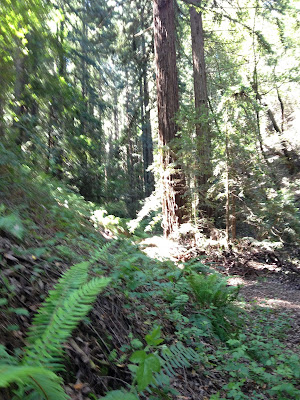 |
| This Red-footed Boobie landed right next to the trail to collect twigs for its nest. I was able to get this photo with my camera-phone! |
Rounding the corner, we could hear the clamor of hundreds of birds. Then the view opened to a hillside covered in white birds, reminding me of an egret colony back home. There was so much activity with birds flying in and out of the area. Some carried sticks in their blue bills, spreading their red feet as they landed in the colony. My first sighting of
Red-Footed Boobies! This hillside in Princeville, Kauai is a prime nesting area for the birds to come together in the spring. Next to the Princeville Lighthouse, a popular tourist destination, the area draws many other species of sea birds to nest and rest.
 |
| Laysan Albatross resting on a hill above the ocean near the Princeville Lighthouse. |
This
Laysan Albatross was another wonderful sighting at the Princeville Lighthouse. Docents said it had been hanging out most of the day on a small hill next to the trail. These seabirds spend most of their lives on the wing, rarely visiting land and can live for up to 60 years. I felt very fortunate to have seen one this close, again getting this photo with the camera on my phone. The Hawaiian Islands are an important nesting refuge for albatross and boobies.
Families of
Nene geese, Hawaii's endangered native goose, roamed the lighthouse grounds. The young geese stayed near their protective parents.
 |
| Nene geese, the Hawaiian State bird, breed on Kauai. |
I had made a special trip to Haleakala on Maui last year to try and see the species. Though we searched around, we only saw a small group flying in the distance. Here on Kauai, they were as common as Canada geese in the Bay Area. They have an amazing come-back story, too, since by 1951 there were only about 30 birds still estimated to exist. Their population rebounded with a great deal of protection from the Endangered Species Act and captive breeding programs to bring them back from the edge of extinction. You can read more about that on the link above.
 |
| Aloha from one happy, retired naturalist! |






Comments
Post a Comment